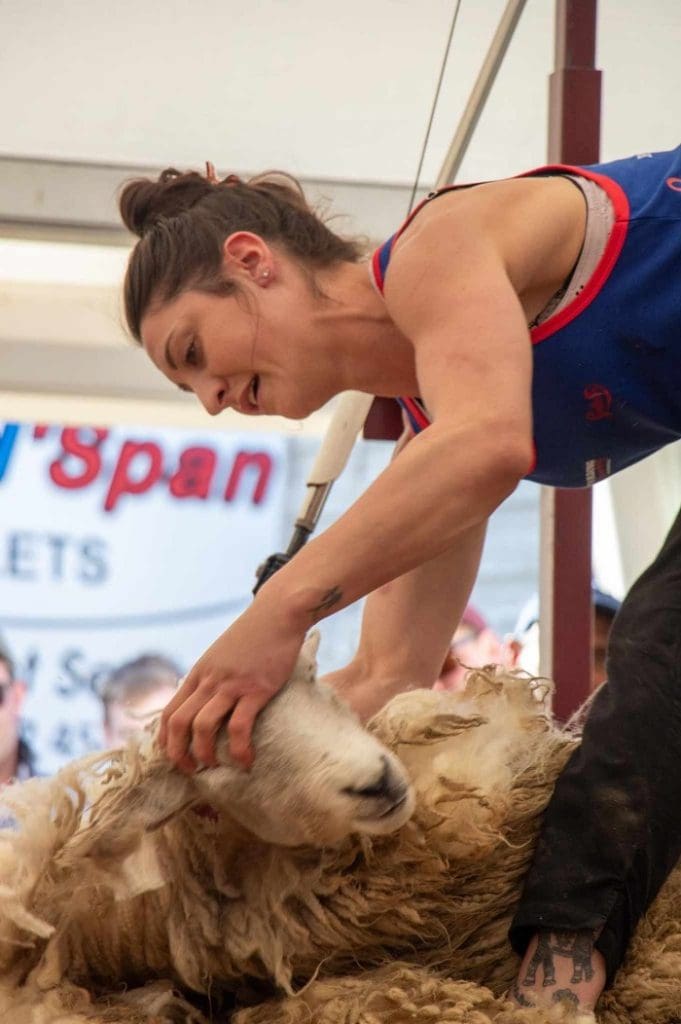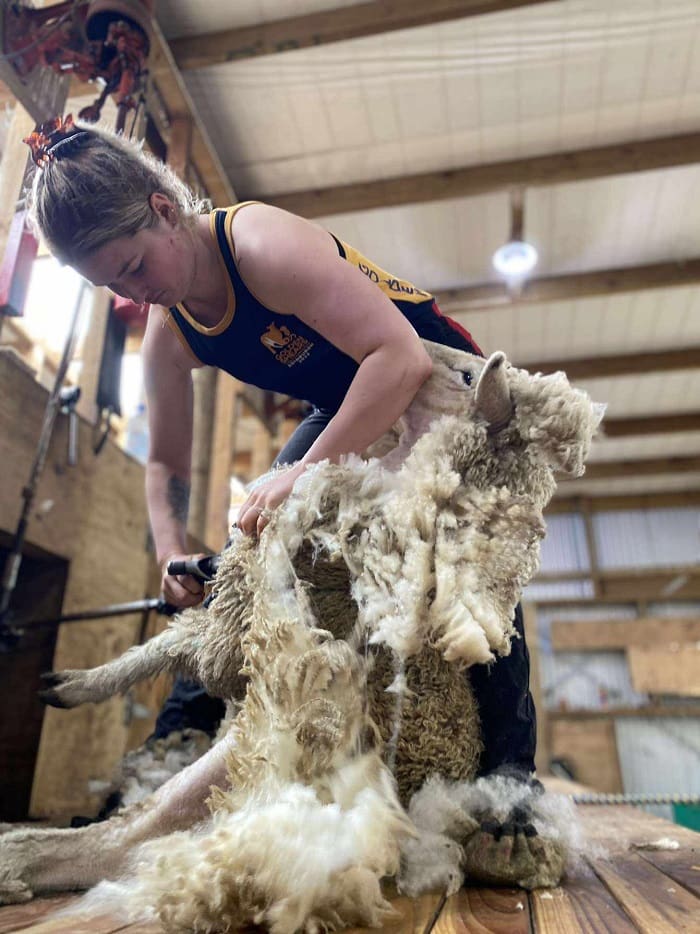
Megan Whitehead, holder of two world shearing records, in preparation for the next attempt on Friday (December 15) in Southland. Image – SSNZ.
THE busiest season of official world shearing records in New Zealand in 55 years will get under way on Friday when two Southland cousins attempt a record set by a Hawke’s Bay mother and daughter in 2009.
In the first of eight record bids in eight weeks, Megan Whitehead, already the holder of two records, will be joined by cousin Hannah McColl in attempts on the solo and two-stand women’s eight-hour strong wool lamb records at Grant Brothers Tin House, 759 Otapiri-Mandeville Road, near Gore.
The current solo record is 601, shorn by Sacha Bond at Fairlight Station, Northern Southland, on February 4 this year, and the two-stand record is 903, shorn by mother-and-daughter Marg Baynes (who shore 433) and Ingrid Baynes (470) at Mangapehi, King Country, on January 13, 2009.
Whitehead currently holds the solo nine-hour record, with 661 shorn amid Covid-19 restrictions at Craigellachie, Southland, on January 14, 2021, and on January 16, 2020, she shore 608 in a women’s four-stand record of 2066, at Waihi Pukawa, near Turangi.

Hannah McColl, will join cousin Megan Whitehead in a two-stand record attempt in Southland on Friday. Image – SSNZ.
The record attempts are being run under the auspices of World Sheep Shearing Records Society with qualified referees monitoring the quality, and three, all involving solo lamb shearing records, will take place before Christmas.
Nine-hour records comprise five runs, the first of two hours followed by four of 1 hour 45 minutes each, generally starting at 5am and ending at 5pm, with one-hour breaks for breakfast and lunch and half-hour breaks for morning and afternoon “smoko” (morning and afternoon tea). Eight-hour records generally start at 7am and end 5pm with an hour off for lunch, plus the smoko-breaks.
Shearers will have been preparing for their record attempts in most cases for over a year, often with running, swimming and gym work before and after the day at work in the woolshed, and there will have been individualised diets.
The costs include records society fees of US$3000 for a single-stand attempt and for multi-stand records, and US$4000 for the first stand and US$1000 per stand thereafter up to a maximum of six stands.
Applicants are responsible for referees accommodation and meals, and generally feed and sate the substantial crews that have helped, usually more than 30 family and friends from throughout the shearing industry, including woolhandlers, pressers, pens crew, cooks, and gear experts.
There is also the “second” who monitors the time and tally to keep the shearer up to task, such as the average 24.23 lambs every 15 minutes (37.15 seconds a lamb, caught, shorn and dispatched) needed when English shearer Stuart Connor claimed the pinnacle nine-hours strong wool lambs record of 872 in England in 2016.
Sample shears in front of the referees are required the day before each attempt to ensure the flock meets wool-weight requirements. For strong wool attempts ewes must be no younger than 18 months old, and the average wool weight must be no less than 3kgs while for lambs the average must be no less than 0.9kg.
It can be tough even getting to the start line, highlighted by events in early November when a three-stand record in West Australia was called off the night beforehand, when the wool did not meet the minimum weight requirement. Among those present was a referee from South Africa.
Last summer there were five record attempts in New Zealand, among 11 worldwide in the year from July 2022 to Junior 2023, including five in Australia and one in England.
In the 2023-2024 year there have already been two solo record bids – one (unsuccessful) in the UK and one (successful) in Australia.
Shearing records have been regulated only since 1968, before when highest tallies were recognised by word of mouth and common consensus.
There were no judges or referees, but sometimes tally days were overseen by Justices of the Peace who verified the count.
It might have established a bit of credibility for the Guinness Book of Records, but it didn’t make them official – there was no way of telling whether it was a level playing field, in terms of preparation of the sheep beforehand and what levels of assistance might have taken place during the day.
In 1968, the Golden Shears International Shearing Championships Society in Masterton took the initiative from shearers at a meeting in Masterton and in June that year a meeting at the New Zealand Wool Board decided on the first formal rules, based on the standard working days of eight hours or nine hours, for solo records, or multi-stand records, in various classifications for ewes, lambs or wethers, and of individual wool types (strong wool being the main New Zealand and UK wool, and Merino (fine wool) the main one in Australia and South Africa.
Record attempts would also have to have ratified shearing judges to ensure a satisfactory quality standard was maintained.
The first record under this regime was at Huiarau Station, East Coast, on November 30, 1968, when Robbie Cooper’s Gang established an eight-stand nine-hours lambs record of 3226. On December 12, 1968, the first solo nine-hours lambs record was set by Graeme Clegg who shore 512 at Waihi Station, near Masterton.
The first women’s record was on December 18, 1971, when Pam Warren shore a women’s solo 9hrs lambs record of 344, at Pio Station, Awakino.
Over the years, rules were tightened, becoming more formal, and in 1983, after a hectic few seasons, the tally for the solo lamb record for nine hours leapt from 637 to 804 in just over 12 months (Nov 1979-Dec 1980). When the World Sheep Shearing Records Society was established, existing records were consigned to a pre-1983 register, and a new register was started.
The society’s website World Sheep Shearing Records Society – Home lists the current “Record Holders” and previous records and some of the historic recognised highest tallies on the “Archives” page, and most record attempts can be followed via livestreaming.
Society secretary Hugh McCarroll said that while eight attempts are currently scheduled at least two others are planned (in Australia and England) according to facebook pages, although applications are yet to be received.



HAVE YOUR SAY